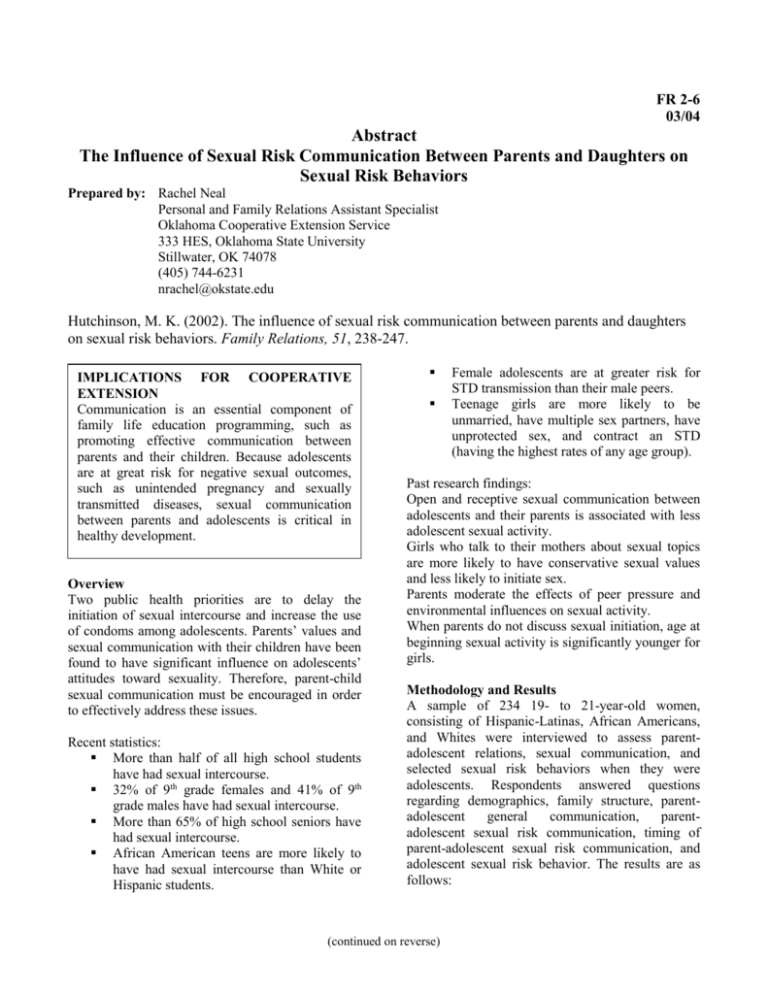
FR 2-6
03/04
Abstract
The Influence of Sexual Risk Communication Between Parents and Daughters on
Sexual Risk Behaviors
Prepared by: Rachel Neal
Personal and Family Relations Assistant Specialist
Oklahoma Cooperative Extension Service
333 HES, Oklahoma State University
Stillwater, OK 74078
(405) 744-6231
nrachel@okstate.edu
Hutchinson, M. K. (2002). The influence of sexual risk communication between parents and daughters
on sexual risk behaviors. Family Relations, 51, 238-247.
IMPLICATIONS FOR COOPERATIVE
EXTENSION
Communication is an essential component of
family life education programming, such as
promoting effective communication between
parents and their children. Because adolescents
are at great risk for negative sexual outcomes,
such as unintended pregnancy and sexually
transmitted diseases, sexual communication
between parents and adolescents is critical in
healthy development.
Overview
Two public health priorities are to delay the
initiation of sexual intercourse and increase the use
of condoms among adolescents. Parents’ values and
sexual communication with their children have been
found to have significant influence on adolescents’
attitudes toward sexuality. Therefore, parent-child
sexual communication must be encouraged in order
to effectively address these issues.
Recent statistics:
More than half of all high school students
have had sexual intercourse.
32% of 9th grade females and 41% of 9th
grade males have had sexual intercourse.
More than 65% of high school seniors have
had sexual intercourse.
African American teens are more likely to
have had sexual intercourse than White or
Hispanic students.
Female adolescents are at greater risk for
STD transmission than their male peers.
Teenage girls are more likely to be
unmarried, have multiple sex partners, have
unprotected sex, and contract an STD
(having the highest rates of any age group).
Past research findings:
Open and receptive sexual communication between
adolescents and their parents is associated with less
adolescent sexual activity.
Girls who talk to their mothers about sexual topics
are more likely to have conservative sexual values
and less likely to initiate sex.
Parents moderate the effects of peer pressure and
environmental influences on sexual activity.
When parents do not discuss sexual initiation, age at
beginning sexual activity is significantly younger for
girls.
Methodology and Results
A sample of 234 19- to 21-year-old women,
consisting of Hispanic-Latinas, African Americans,
and Whites were interviewed to assess parentadolescent relations, sexual communication, and
selected sexual risk behaviors when they were
adolescents. Respondents answered questions
regarding demographics, family structure, parentadolescent
general
communication,
parentadolescent sexual risk communication, timing of
parent-adolescent sexual risk communication, and
adolescent sexual risk behavior. The results are as
follows:
(continued on reverse)
The Influence of Sexual Risk Communication Between Parents and Daughters on Sexual Risk
Behaviors (continued)
Hispanic-Latina respondents reported less
parent-adolescent sexual communication
than others. However, family and religious
norms may limit parent-adolescent sexual
communication. For example, those families
with conservative religious views or strong
beliefs that any type of premarital sexual
behavior is immoral may be uncomfortable
and less likely to encourage sexual
communication.
Early
parent-adolescent
sexual
communication was associated with later
age of sexual initiation, consistent condom
use, and less likelihood of sexually
transmitted diseases.
Mother-daughter communication about
condoms was associated with consistent
condom use during adolescence.
listening skills and examine their own fears and
attitudes toward sexuality.
Lastly, sexual communication may be most effective
when it occurs before the adolescent becomes
sexually active. Therefore, family-based programs
should promote preadolescent parent-child sexual
communication.
Recommendations
for
Family-Based
Prevention/Intervention
Lower levels of sexual communication were found
with fathers. However, daughters reported that
fathers were important sources of support.
Therefore, family prevention/intervention programs
should
promote
father-daughter
sexual
communication by including program components
targeting fathers and their unique roles and needs
regarding parent-adolescent sexual communication
(e.g., goals for children’s sexual socialization; the
role of fathers in sexual socialization; active
listening and open communication skills).
Non-urban (suburban and rural) respondents
reported
less
parent-adolescent
sexual
communication, perhaps because non-urban parents
are less aware of the sexual risks facing adolescents
today. In addition, non-urban parents have reported
that while they believe that sexual communication is
important, they are unaware of how and when to
initiate sexual conversations. Therefore, family
professionals need to raise parental awareness about
STDs, HIV, and current rates and patterns of
adolescent sexual behavior, as well as information
and opportunities to practice communication and
(continued on reverse)







